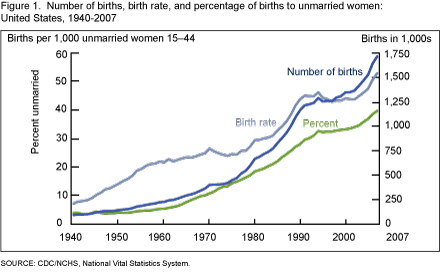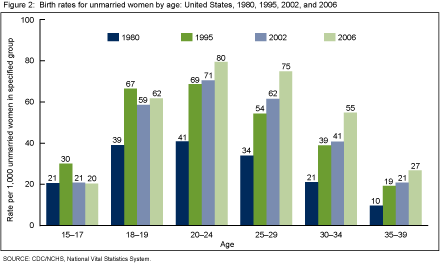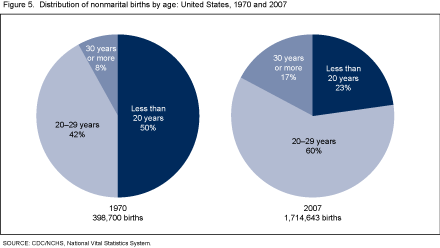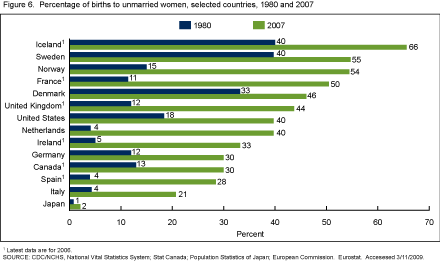Contact Us:
- National Center for Health Statistics
3311 Toledo Rd
Hyattsville, MD 20782 - 1 (800) 232-4636
- Contact CDC–INFO
NCHS Data Brief
Number 18, May 2009
Changing Patterns of Nonmarital Childbearing in the United States
On this Page
- Key findings
- What has happened to the key indicators of nonmarital births?
- Has the rate of childbearing for unmarried women changed by age?
- How have nonmarital birth rates varied by race and Hispanic origin?
- Have the proportions of births to unmarried women increased across the age spectrum?
- Are births to unmarried mothers mostly to teenagers?
- How does the United States compare with other countries in nonmarital childbearing?
- Summary
- Definitions
- Data source and methods
- About the authors
- References
- Suggested citation
PDF Version (704 KB)
by Stephanie J. Ventura, M.A., Division of Vital Statistics
Key findings
Data from the Natality Data Sets, National Vital Statistics System (NVSS)
- Childbearing by unmarried women has resumed a steep climb since 2002.
- Births to unmarried women totaled 1,714,643 in 2007, 26% more than in 2002. Nearly 4 in 10 U.S. births were to unmarried women in 2007.
- Birth rates have risen considerably for unmarried women in their twenties and over, while declining or changing little for unmarried teenagers.
- Nonmarital birth rates are highest for Hispanic women followed by black women. Rates for non-Hispanic white and Asian or Pacific Islander women are much lower.
- Most births to teenagers (86% in 2007) are nonmarital, but 60% of births to women 20–24 and nearly one-third of births to women 25–29 were nonmarital in 2007.
- Teenagers accounted for just 23% of nonmarital births in 2007, down steeply from 50% in 1970.
Childbearing among unmarried women has been the subject of intense public policy and public health concern for decades (1,2), much of it reflecting concerns about the impact on family structure and the economic security of children. Nonmarital births are at higher risk of having adverse birth outcomes such as low birthweight, preterm birth, and infant mortality than are children born to married women (2,3). Children born to single mothers typically have more limited social and financial resources (4).
This report examines data on nonmarital births from the National Vital Statistics System (NVSS). The principal measures reviewed are the number of births to unmarried women, the birth rate for unmarried women, and the percentage of all births to unmarried women. The most recent data available are from the 2007 preliminary birth file (5). Data for 2006 are shown where the 2007 data are not available. Comparisons are also made with selected earlier years reflecting key points of change.
Keywords: nonmarital births, birth rates, marital status, race and Hispanic ethnicity
What has happened to the key indicators of nonmarital births?
In 2007, there were 1,714,643 babies born to unmarried women, an increase of 4% from 2006, and 26% higher than the number in 2002 (1,365,966). The 2007 total is 2.5 times the number reported in 1980 and 19 times the estimate for 1940 (89,500) (2,5,6).
The birth rate for unmarried women in 2007 was 52.9 births per 1,000 unmarried women aged 15–44 years. The rate increased 5% between 2006 and 2007 and 21% since 2002 (43.7). The rate for 2007 was 80% higher than the rate for 1980.
In 2007, nearly 4 in 10 births were to unmarried women: The proportion of all births to unmarried women was 39.7%, up from 34.0% in 2002. The 2007 proportion was more than double that for 1980 (18.4%).
Has the rate of childbearing for unmarried women changed by age?
Nonmarital birth rates vary considerably by age. Rates are typically lowest for young teenagers and women aged 35–39 years and over, and are highest for women in their early twenties.
From 1995 to 2002, birth rates for unmarried teenagers declined: The rate for younger teens dropped 30% for ages 15–17 years, and 12% for older teens. Between 2002 and 2006, the rates declined slightly for young teenagers and increased 5% for older teenagers.
Birth rates for women in age groups 20–24 years and over increased moderately between 1995 and 2002, with increases ranging from 3% (ages 20–24) to 15% (ages 25–29).
Since 2002, birth rates for adult women have risen much more, with increases ranging from 13% for women aged 20–24 years to 34% for women 30–34 years.
How have nonmarital birth rates varied by race and Hispanic origin?
Birth rates for unmarried women have varied fairly consistently by race and Hispanic origin. The rates for Hispanic women (106 births per 1,000 unmarried women in 2006) and black women (72 per 1,000) were highest. Birth rates for unmarried non-Hispanic white (32 per 1,000) and Asian or Pacific Islander (API) women (26 per 1,000) were much lower.
From 1995 to 2002, the nonmarital birth rate for black women declined 12%. Rates for non-Hispanic white and Hispanic women were essentially unchanged during these years.
In the recent period 2002–2006, birth rates for unmarried non-Hispanic white women rose by 14% and for black women by 9%, while the rates climbed 20% for Hispanic women and 24% for API women.
Have the proportions of births to unmarried women increased across the age spectrum?
While nonmarital birth rates were fairly stable from the mid 1990s to 2002, before the recent increases, the proportions of births to unmarried women have risen throughout the period since 1980 for women under 30 years of age. The proportions for women aged 30–34 and over changed little from the mid 1990s to 2002 but have since increased considerably.
The overwhelming majority of births to teenagers are to unmarried women. In 2007, 93% of births to 15–17 year-olds and 82% of births to 18–19 year-olds were nonmarital.
Sixty percent of births to women aged 20–24 years in 2007 were nonmarital compared with 52% in 2002. Nearly one-third of births to women aged 25–29 years were to unmarried women in 2007, up from one-fourth in 2002. Overall, 45% of births to women in their twenties were to unmarried women in 2007.
Nearly one in five births to women in their thirties were nonmarital in 2007 compared with one in seven in 2002.
Are births to unmarried mothers mostly to teenagers?
At one time, references to births to unmarried women and births to teenagers were considered one and the same only because births to unmarried women were disproportionately, although certainly not exclusively, among teenagers. In 1970, 50% of nonmarital births were to unmarried women under age 20.
In the years since the mid-1970s, this proportion has fallen steadily. In 2007, 23% of nonmarital births were to teenagers. The decline largely reflects the drop in birth rates for unmarried teenagers concurrent with the large increases in birth rates for adult unmarried women.
Sixty percent of nonmarital births in 2007 were to women in their twenties, significantly higher than the 42% level in 1970.
About one in six births to unmarried women in 2007 were to women aged 30 years and over, much higher than the proportion in 1970, 1 in 12.
How does the United States compare with other countries in nonmarital childbearing?
The United States is not unique, nor does it outpace other countries, in nonmarital childbearing. For example, well over one-half of recent births to Icelandic, Swedish, and Norwegian women were nonmarital. Proportions of nonmarital births were also high for births to French and Danish women (7).
The proportions in the United States nonetheless are considerably higher than in some industrialized countries. For example, 30% or less of recent births were to unmarried women in Germany, Spain, Canada, Italy, and Japan (7–9).
The upward trend in nonmarital childbearing seen in the United States is matched in most developed countries, with levels at least doubling or tripling and in some cases increasing many multiples between 1980 and the mid-2000s.
Summary
The number of infants born to unmarried women in the United States reached an historic peak in 2007, at 1,714,643. After relative stability in the key measures of nonmarital childbearing from the mid-1990s to 2002, these measures have risen sharply. The number of births rose 26% and the birth rate for unmarried women climbed 21% during 2002–2007. Nearly 4 in 10 U.S. births in 2007 were to unmarried women. The recent increases in nonmarital births have been widespread across race and Hispanic ethnicity groups. Adult women aged 20 and over have accounted for much of these increases. In earlier decades, references to teenage and nonmarital childbearing were used interchangeably, because large proportions of unmarried mothers were teenagers. In recent years, less than one-fourth of nonmarital births were to teenaged women. Despite the currently older age profile of unmarried mothers, concerns remain because their infants are at greater risk of low birthweight, preterm birth, and dying in infancy, and are more likely to live in poverty than babies born to married women (3,4,6).
The historic increases in nonmarital childbearing result from many factors, including substantial delays in marriage beginning with the baby-boom generation and changes in sexual activity, contraceptive effectiveness and use, and abortion (1,2, 10–12). Many infants are also born to couples in cohabiting relationships: According to the 2002 National Survey of Family Growth (NSFG), about 40% of recent nonmarital births were to cohabiting women (10). In addition, there have been attitudinal changes. The societal disapproval that unmarried mothers faced at one time has diminished sharply (13). With the availability of more detailed birth data for 2007 from the vital statistics system and new data from the 2006–2008 NSFG, it will be possible to monitor current trends in the behaviors and attitudes that affect fertility patterns for unmarried women and the health outcomes for their babies.
Definitions
Unmarried woman: A woman who has never married or is widowed or divorced. Marital status on the birth certificate is based on the woman’s legal marital status.
Nonmarital birth: A birth to an unmarried woman. The mother’s marital status is based on a question on the birth certificate. In most states, the question is: “Mother married? (At birth, conception, or any time between) (Yes or No).” Additional information on the classification of births by marital status is available elsewhere (2,6).
Birth rate for unmarried women: The number of births (regardless of age) to unmarried women per 1,000 unmarried women aged 15–44 years. Birth rates are also computed for specific age, race, and Hispanic ethnicity groups.
Data source and methods
This report contains data from the Natality Data File from the NVSS. The vital statistics natality file includes information for all births occurring in the United States. Mother’s marital status is collected by all states. For all but two states, the information is collected by a direct question in the birth registration process. Marital status is inferred in New York and Michigan. A birth is inferred as nonmarital if a paternity acknowledgment was filed or if the father’s name is missing from the birth certificate. The natality files include information on a wide range of maternal and infant demographic and health characteristics for babies born in the United States. Data may also be accessed from the interactive data access tool, VitalStats.
About the authors
Stephanie J. Ventura is with the Centers for Disease Control and Prevention’s National Center for Health Statistics, Division of Vital Statistics, Reproductive Statistics Branch.
References
- Ventura SJ, Bachrach CA, Hill L, Kaye K, Holcomb P, Koff E. The demography of out-of-wedlock childbearing. In: National Center for Health Statistics. Report to Congress on Out-of-Wedlock Childbearing. Hyattsville, MD: National Center for Health Statistics. 1995.
- Ventura SJ, Bachrach CA, Nonmarital childbearing in the United States, 1940–99. National vital statistics reports; vol 48 no 16. Hyattsville, MD: National Center for Health Statistics. 2000.
- Mathews TJ, MacDorman MF. Infant mortality statistics from the 2005 period linked birth/infant death data set. National vital statistics reports; vol 57 no 2. Hyattsville, MD: National Center for Health Statistics. 2008.
- McLanahan S. The consequences of nonmarital childbearing for women, children, and society. In: National Center for Health Statistics. Report to Congress on Out-of-Wedlock Childbearing. Hyattsville, MD: National Center for Health Statistics. 1995.
- Hamilton BE, Martin JA, Ventura SJ. Births: Preliminary data for 2007. National vital statistics reports; vol 57 no 12. Hyattsville, MD: National Center for Health Statistics. 2009.
- Martin JA, Hamilton BE, Sutton PD, Ventura SJ, Menacker F, et al. Births: Final data for 2006. National vital statistics reports; vol 57 no 7. Hyattsville, MD: National Center for Health Statistics. 2009.
- European Commission. Eurostat. Live births outside marriage. Accessed March 11, 2009.
- Statistics Canada. Canadian vital statistics. Birth database.
- National Institute of Population and Social Security Research. Population statistics of Japan 2008. Accessed March 11, 2009.
- Chandra A, Martinez GM, Mosher WD, Abma JC, Jones J. Fertility, family planning, and reproductive health of U.S. women: Data from the 2002 National Survey of Family Growth. National Center for Health Statistics. Vital Health Stat 23(25). 2005.
- Mosher WD, Martinez GM, Chandra A, Abma JC, Willson S. Use of contraception and use of family planning services in the United States, 1982–2002. Advance data from vital and health statistics; no 350. Hyattsville, MD: National Center for Health Statistics. 2004.
- Ventura SJ, Abma JC, Mosher WD, Henshaw SK. Estimated pregnancy rates by outcome for the United States, 1990–2004. National vital statistics reports; vol 56 no 15. Hyattsville, MD: National Center for Health Statistics. 2008.
- Martinez GM, Chandra A, Abma JC, Jones J, Mosher WD. Fertility, contraception, and fatherhood: Data on men and women from Cycle 6 (2002) of the National Survey of Family Growth. National Center for Health Statistics. Vital Health Stat 23(26). 2006.
Suggested citation
Ventura SJ. Changing patterns of nonmarital childbearing in the United States. NCHS data brief, no 18. Hyattsville, MD: National Center for Health Statistics. 2009.
Copyright information
All material appearing in this report is in the public domain and may be reproduced or copied without permission; citation as to source, however, is appreciated.
National Center for Health Statistics
Director
Edward J. Sondik, Ph.D.
Acting Co-Deputy Directors
Jennifer H. Madans, Ph.D
Michael H. Sadagursky








